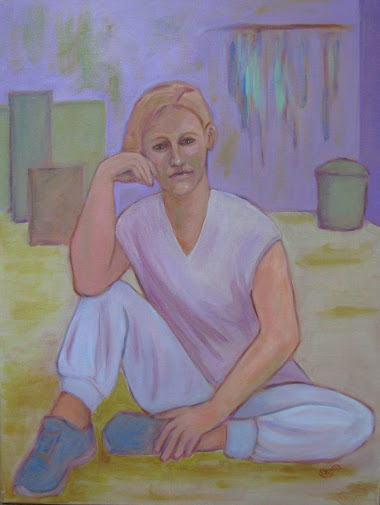To-do lists and project plans have always been essential components of my modus operandi. The satisfaction of check-check-checking and the feeling that I'm making progress keep me moving on to my next act. Some of these strategies work in my Homegrown Art School – renamed since early COVID days, my Artist-in-Residence program. Yup, I can lay out a big plan but when it comes to putting paint to canvas, things sometimes go awry.
But that never stops me. I am making progress, really I am, in my "Jury is Out" series (recapped last time) and my aim to work in the style of long-time favourite artist-teacher Mary Beth McKenzie.
I tried various sketched poses and eventually decided on a sitting pose and did some painted studies of a face that might be useful. Working from a scaled-up magazine shot -- conveniently the reverse of the pose I'd decided on -- I laid out the basic composition.
In books and videos, I'd been observing different artists' practices in beginning a painting. In this review, I noticed again a quote from Mary Beth that had struck me years ago:--
"While an initial concept is important, you must allow a painting to take its own course. It will grow in stages, and each stage, and your reaction to it, influences the next. A painting has its own existence and reality, and you have to follow its needs, making changes freely. Often these changes take you in another direction, opening up new possibilities that are sometimes more interesting than your original idea. You have to allow a painting to evolve."
I'd planned to use certain colours, including a dark blue-black for the female's hair, and began to build these up gradually as I "kept the whole thing going at once" (- an almost but not quite universal artist's dictum).
By this point, I was learning some interesting things about working with close tonal values (avoiding strong contrasts in darks and lights) – and decided I could learn even more if, to some extent, I emulated the light colours in the cover painting of the McBible.
I kept going in this direction but began to think I'd have been better off to try to "copy" that cover painting – and I became more and more hesitant to press onward. So with a few lessons learned, I laid a few more layers and decided to call it quits with "The Jury is Out (Mary Beth)" copyright 2021. (Maybe I'll be like Matisse and sneak into the museum months after the painting is purchased and hung to put some more strokes on the canvas! Haha.)
Still – there was one more thing I wanted to try, a technique referred to by my Hero Artist. (We don't say "heroine" any more, I guess). This is the use of a palette knife, either to lay out a broad swath of paint or, with the knife's narrow edge, to "cut" a very fine line of paint. And I have plenty of barely used palette knives!
For my experiment, I selected one lucky candidate from the Cardboard Club – that cozy collection of faces I've produced from time to time to use up excess paint.
Then I swathed and sliced with abandon – thanking my lucky stars that I hadn't tried this technique at a late stage of "Jury."
Wow. This now resembles one of those frostbitten arctic explorers who, having lost their bearings, has just made it back to civilization through an unexpected blizzard. It's time to close the book on this lesson, isn't it?











No comments:
Post a Comment